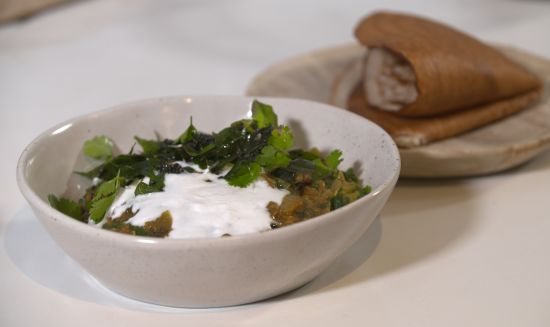
Megan…
… is a plant-based chef who founded Little Bird Organics littlebirdorganics.co.nz
Here’s her recipe for…
And here’s the webisode.
This is such a comforting meal and incredibly good for you as well. Eating lentils and other legumes regularly is an indicator of longevity in population studies! Cheap, easy to cook and good for you, there are many reasons to add them into your diet. Plus this dahl is delicious!
In this dish I use both cooked and sprouted lentils so you get the extra protein and micro-nutrients out of the sprouted ones. The silverbeet works really well in the dahl. You could use other hard greens like spinach or cavolo nero, but if you have silverbeet I would recommend that as the flavour works well. Adding it at the last minute gives the dish a touch of freshness and leaves the meal feeling less heavy than a regular dahl.
1 cup red split lentils
1 teaspoon ground turmeric
½ teaspoon salt
2-3 cups water
1 onion, finely chopped
1 tablespoon sesame oil
2 cups lentil sprouts*
1 tablespoon coconut oil
2 twigs of curry leaves
1 tablespoon black mustard seeds
pinch salt
6 leaves of silverbeet, chopped
coconut yoghurt (optional)
fresh coriander (optional)
2 teaspoons coriander seeds
2 teaspoons cumin seeds
1 teaspoon black peppercorns
6 cardamom pods
½ – 2 dried red chillis
1 teaspoon ground cinnamon
¼ teaspoon ground cloves
Put lentils in a pot with turmeric, salt and water. Boil gently for 35-40 minutes or until they are starting to thicken.
Put heavy-based frypan on a medium heat. Add spices from the Spice Blend list (all except the cinnamon and cloves) dry into the pan and toast. Don’t overcook them – they’re ready when they’re fragrant and slightly toasted.
Put toasted spices in a spice mill or coffee grounder and add cinnamon and cloves. Blend well.
Melt coconut oil in a pan, then when hot, add onion. Cook until transparent, not browned.
Add onions and spices to the dahl as well the lentil sprouts.
To make the topping, heat pan to medium heat. Add coconut oil and when hot, add curry leaves which will make a popping sound. Then add mustard seeds which will also pop. Make sure you don’t burn the mustard seeds which is easy to do if you cook it too long.
Take dahl off the heat and stir silverbeet through. The silverbeet doesn’t need to be cooked on the heat – it will wilt and soften in the hot dahl.
Place dahl in a bowl. Add a spoonful of coconut yoghurt (if using). Sprinkle on crispy curry leaves and some fresh coriander (if using).
Serve with a fermented brown rice and lentil dosa – see recipe below. Alternatively serve with poppadoms or brown rice.
*Lentil sprouts take 2-3 days to make. Cover lentils in a bowl with water. Rinse them every morning and every evening and add more water. They’ll have sprouted in 2-3 days.
1½ cups medium-grain brown rice
½ cup urad dal (split, skinned black gram)
1/3 cup + 2 tablespoons brown rice flakes
pinch of fenugreek seeds
2 pinches of sea salt
neutral-tasting oil like sesame or sunflower oil
Place all ingredients except salt and oil in a bowl and cover generously with filtered water. Leave to soak on a bench top covered with a clean tea towel for 3–5 hours. Strain off the water into a bowl and keep, and place the solids in a high-speed blender. Add half the soaking water and blend into a batter, adding a little extra water as needed to make a fluid pancake-style batter. Note that it will thicken further when you ferment it.
Place the mixture in a non-reactive (glass or ceramic) bowl and leave overnight covered with a clean tea towel or plate in a warm place to ferment. In the morning you will see some activity, with bubbles in the mixture, and notice a change to a pleasant sour smell and taste. Add salt and lightly mix through with a fork.
Store in the fridge for up to one 1 week, although it’s best used within the first 3–4 days.
To cook dosas, heat a large, heavy-based-cast iron frying pan to a medium-high heat (you can get a dosa pan from your local Indian specialist store). Add a few drops of oil, coating the pan very thinly. If you use too much oil, your dosa will stick to the pan.
Place ¾ cup of dosa batter in the centre of the pan and use the back of a metal measuring cup or soup spoon to spread it out in a circular motion until it reaches the edges of the pan. Turn the heat down to medium and cook for 3–4 minutes or until golden brown, then flip over, adding a few more drops of oil to the pan, and cook for another 2–3 minutes until golden brown on the other side.
… is a naturopath and nutritionist nelliepigot.co.nz
Silverbeet is a vegetable high in phytonutrients and antioxidants and it’s anti-inflammatory.
It has a unique benefit for blood sugar regulation. It contains a flavonoid called syringic acid which inhibits the breakdown of carbohydrates to simple sugars. So fewer carbs are broken down and that means more stable blood sugar.
Silverbeet is a standout for bone support as it’s exceptionally high in Vitamin K, calcium and manganese. Vitamin K prevents the breakdown of bone, it helps anchor calcium in bone and reduces the urinary excretion of calcium, all of which adds up to keeping your bones stronger.
Website designed by www.thecornerstorecollective.com
Developed by Richard Hpa